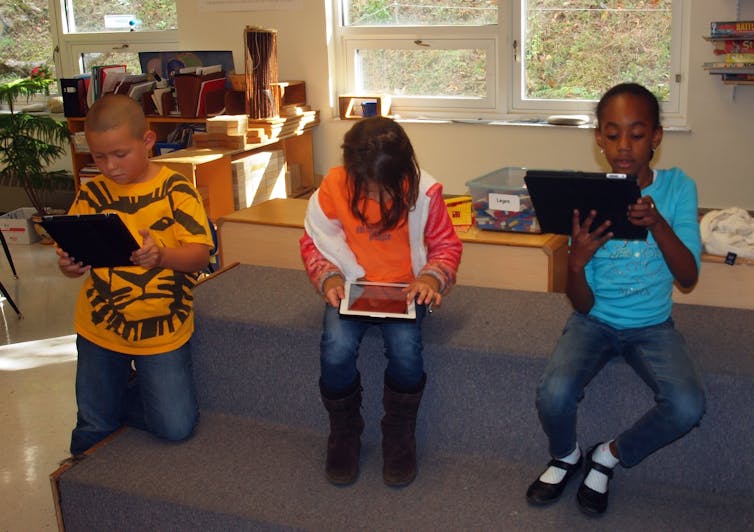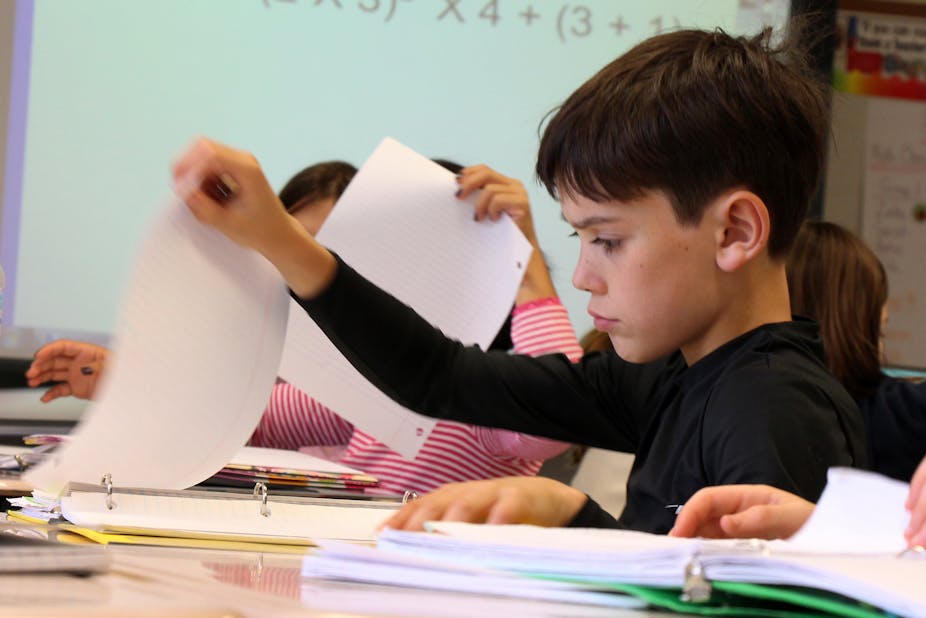Children show a vastly improved ability to absorb knowledge when they are allowed to make some of their own decisions about what they want to learn.
Testing, in other words, gets in the way – and worse.
Indeed, as the No Child Left Behind (NCLB) legislation comes up for re-authorization this week President Obama has himself stated that testing should be cut down to “a bare minimum.”
Testing was introduced by policymakers during the eighties as a way to measure how much kids were learning in classrooms. But now there is research that shows it is detrimental and that technology may offer better ways to track learning.
Learning skills in first grade
My own research has shown that children develop a range of sophisticated capabilities when their learning environments allow them, at least in part, to decide how and what they learn.
I spent four years in Texas first grade classrooms, as part of my Agency and Young Children project where students - mostly children of immigrants - were allowed to choose research topics, move freely around their classroom, and collaborate on projects.
I observed these young children gain critical literacy and numeracy skills. Children, who had initially refused to learn English, became so engaged that they started writing Spanish and English words to label a model volcano. Instead of resisting learning in English or Spanish, they started asking for more and more words.
When children feel comfortable sharing their stories, they write better. When children can initiate conversations, they are more likely to listen to one another. And when children have what I call “agency” or the ability to influence or make decisions in their learning, they develop a wider and deeper range of capabilities than just standard math and literacy skills.
It was policy-makers, who without much input from teachers, researchers or parents, started pushing for testing, starting in the 1980s and leading upto the early 1990s.

Over time, it was seen that testing was not the best measure. Researchers at Stanford have, in fact, found that testing is a terrible, stand-alone measure of accountability.
Other evidence against testing has been mounting as well. Earlier in 2015, teachers testifying to Congress emphasized the effects of standardized testing on teaching and learning from NCLB.
Creative use of technology could replace testing
Perhaps, the most troubling of these are the harsh realities of how testing pressures change the learning experiences of kindergarteners and preschoolers.
The National Association for the Education of Young Children (NAEYC) argues that testing for young children should be developmentally appropriate as well as have some benefit to the child.
In an attempt to move away from testing, some teachers are using technology to broaden and deepen the ways children can demonstrate what they know and can do. Relatively accessible recording devices found on phones, iPads and cameras can be used by children to demonstrate what they are learning.
For example, I recently visited a teacher in Austin who is using croak.it to share with parents what their children are learning about the civil rights movement and ideas about race, justice and community.
Early testing leads to labeling, and parent anxiety
Testing emphasizes learning as “right and wrong answers”, which is not the way most kids learn. Kids have been shown to learn through trial and error as well as discovery. Testing values directions and achievement over creativity and a range of learning experiences.
In addition, early testing leads to early labeling, parent anxiety as well as teacher recruitment and retention issues. Testing has a demonstrable detrimental impact even on children’s happiness.
As an early childhood teacher educator, I find myself sympathizing with teachers who, under pressure from administrators and policymakers, have to prepare young children to be successful on tests that begin in third grade.
Testing has pressured teachers to move away from experiments, discovery and creative projects to more instruction and directions. Kindergarten teachers are being asked to prepare children for right and wrong answers, instead of creating lesson plans that allow children to make their own decisions.
No longer do five year olds in schools spend their days in imaginative play, or design. In fact, young children often go hours without recess or the ability to move and explore.
Just a few months ago in a well-performing Texas school, I saw classrooms where five-year-old children were trying to follow their enthusiastic and kind teachers through 90 minutes of district-mandated literacy instruction using a 300-page textbook.
Teachers find it difficult to get to know children and their families or to build on the individual strengths and interests of the increasingly diverse groups of kids in their classrooms.
This is even more problematic for the over one in four children from immigrant communities whose parents face disproportionate barriers in working with teachers and schools.
Testing leads to teacher retention issues
Sometimes advocates for standardized testing argue that tests, including benchmark or “school readiness” tests help catch learning problems early.
Yet, usually, it is a smart, thoughtful, observant teacher who, by watching, engaging and interacting with children each day, spots someone having trouble with oral language, fine motor skills, conflict or letter recognition.
So much testing also puts us at risk of losing teachers.The National Education Association (NEA) reports that nearly half of teachers want to leave the profession because of standardized testing.
These concerns about testing are now being reflected in President Obama’s keenness to cutt down testing. But if leaders are serious about changing the testing climate in schools, they need to act fast for the sake of the youngest students.
As one teacher sadly explained to me during a workshop on children’s agency, “It is hard to give kids a lot of freedom in my classroom when I don’t really have any myself.”

